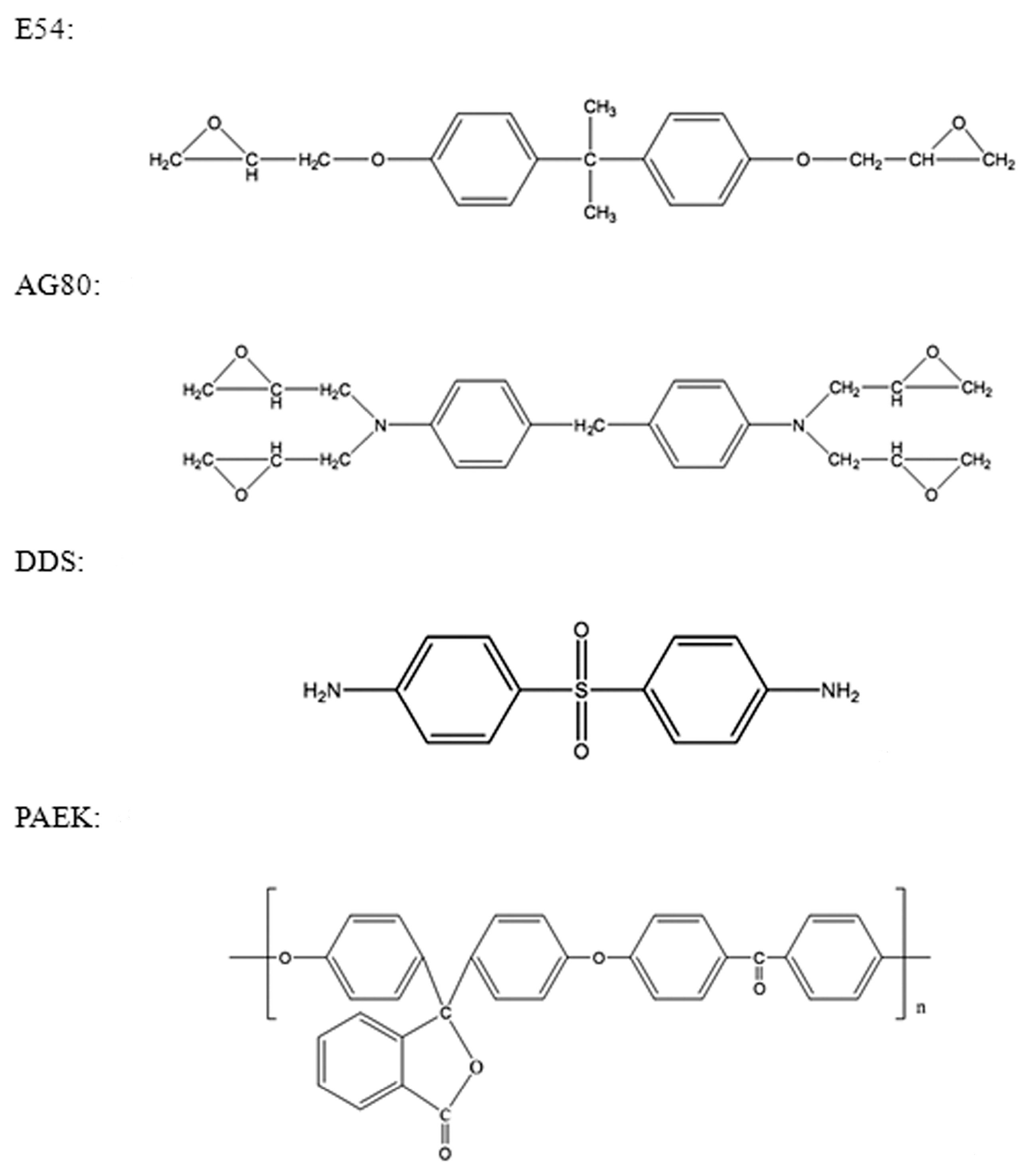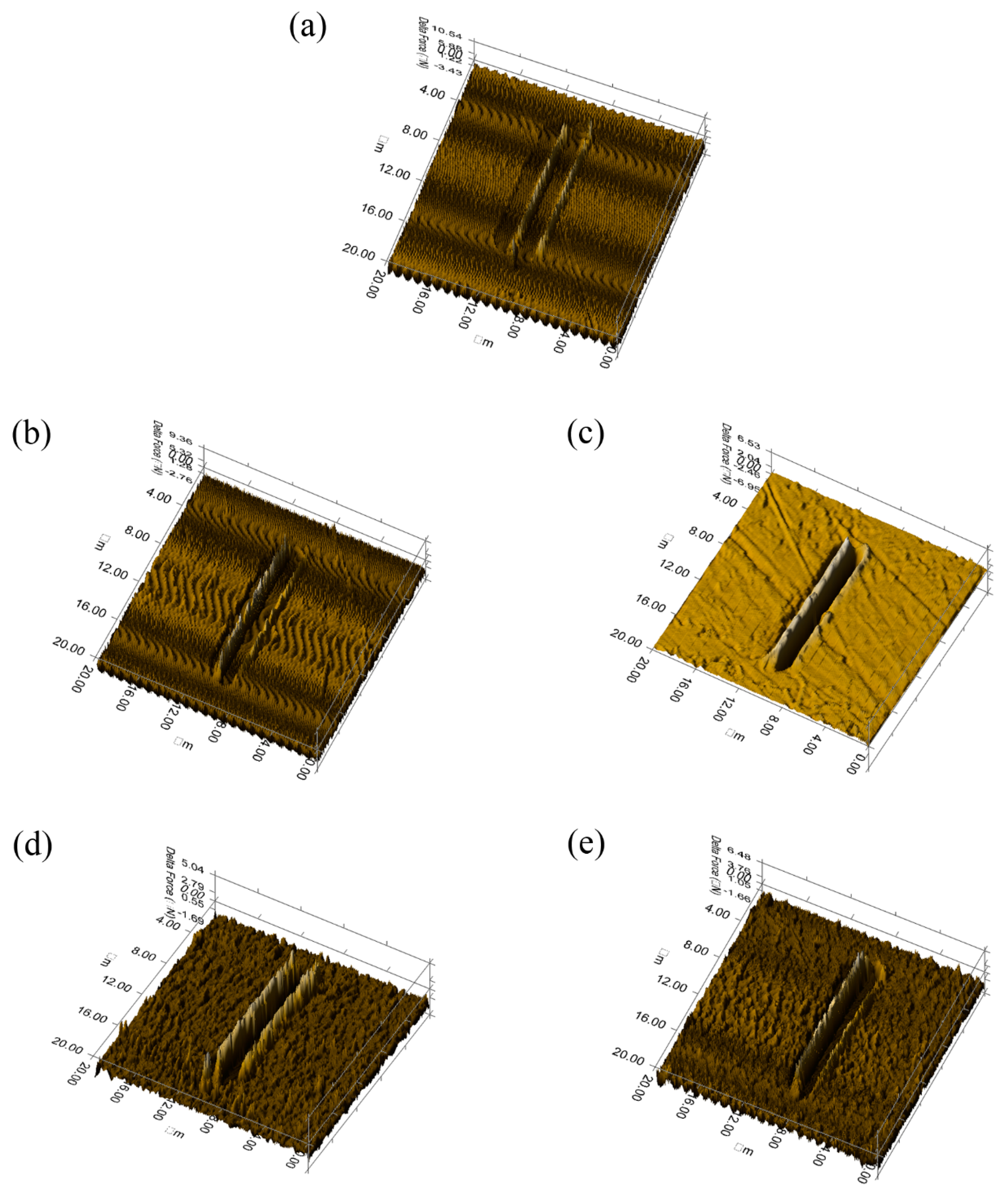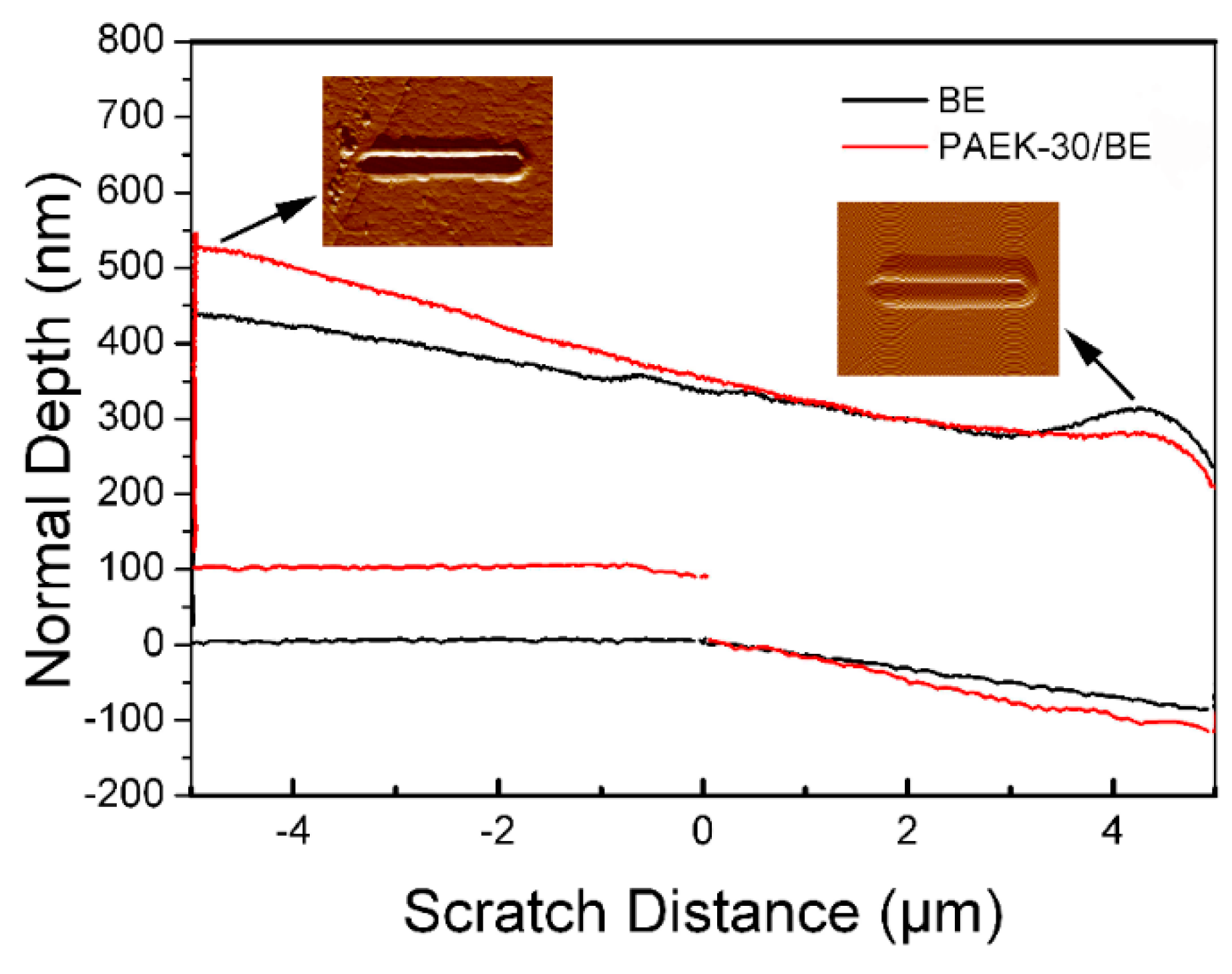Nanomechanical Properties of a Bicomponent Epoxy Resin via Blending with Polyaryletherketone
Abstract
:1. Introduction
2. Experimental Details
2.1. Raw Materials and Reagents
2.2. Preparation of Epoxy Resin Casting Blends
2.3. Microstructure Characterization
2.4. Nanoindentation and Nanoscratch Tests
3. Results and Discussion
3.1. Microstructure Characterization
3.2. Nanoindentation Properties
3.3. Nanoscratch Properties
4. Conclusions
Author Contributions
Funding
Conflicts of Interest
References
- Dasari, A.; Yu, Z.Z.; Mai, Y.W. Nanoscratching of nylon 66-based ternary nanocomposites. Acta Mater. 2007, 55, 635–646. [Google Scholar] [CrossRef]
- Wasmer, K.; Gassilloud, R.; Michler, J.; Ballif, C. Analysis of onset of dislocation nucleation during nanoindentation and nanoscrataching of InP. J. Mater. Res. 2012, 27, 320–329. [Google Scholar] [CrossRef]
- Saeed, Z.C.; Xu, S.Z. Nanoindentation/scratching at finite temperatures: Insights from atomistic-based modeling. Prog. Mater. Sci. 2019, 100, 1–20. [Google Scholar]
- Liver, W.C.O.; Pharr, G.M. Improved technique for determining hardness and elastic-modulus using load and displacement sensing indentation experiments. J. Mater. Res. 1992, 7, 1564–1583. [Google Scholar]
- Zhou, H.X.; Qiu, S.; Zhang, X.Z.; Xu, C. Mechanical characteristics of soft-brittle HgCdTe single crystals investigated using nanoindentation and nanoscratching. Appl. Surf. Sci. 2012, 258, 9756–9761. [Google Scholar] [CrossRef]
- Gouldstone, A.; Chollacoop, N.; Dao, M.; Li, J.; Minor, A.M.; Shen, Y.L. Indentation across size scales and disciplines: Recent developments in experimentation and modelling. Acta Mater. 2007, 55, 4015–4039. [Google Scholar] [CrossRef]
- Wong, M.; Lim, G.T.; Moyse, A.; Reddy, J.N.; Sue, H.J. A new test methodology for evaluating scratch resistance of polymers. Wear 2004, 256, 1214–1227. [Google Scholar] [CrossRef]
- Wong, J.S.S.; Sue, H.J.; Zeng, K.Y.; Li, R.K.Y.; Mai, Y.W. Scratch damage of polymers in nanoscale. Acta Mater. 2004, 52, 431–443. [Google Scholar] [CrossRef]
- Kim, J.K.; Hodzic, A. Nanoscale characterisation of thickness and properties of interphase in polymer matrix composites. J. Adhesion 2003, 79, 383–414. [Google Scholar] [CrossRef]
- Carreon, A.H.; Funkenbusch, P.D. Material specific nanoscratch ploughing friction coefficient. Tribol. Int. 2018, 126, 363–375. [Google Scholar] [CrossRef]
- Fischer-Cripps, A.C. The IBIS Handbook of Nanoindentation; Part 1; Fischer-Cripps Laboratories Pty Ltd.: Forestville, Australia, 2009. [Google Scholar]
- Chiao, L. Mechanistic reaction kinetics of 4,4′-Diaminodiphenyl sulfone cured tetraglycidyl 4,4′-Diaminodiphenylmethane epoxy resins. Macromolecules 1990, 23, 1286–1290. [Google Scholar] [CrossRef]
- Zhang, X.J.; Yi, X.S.; Xu, Y.Z. Cure-induced phase separation of Epoxy/DDS/PEK-C composites and its temperature dependency. J. Appl. Polym. Sci. 2008, 109, 2195–2206. [Google Scholar] [CrossRef]
- Zhang, M.; An, X.F.; Tang, B.M.; Yi, X.S. TTT diagram and phase structure control of 2/4 functional epoxies blends used in advanced composites. Front. Mater. Sci. 2007, 1, 81–87. [Google Scholar] [CrossRef]
- Xiang, C.; Sue, H.J.; Chu, J.; Coleman, B. Scratch behavior and material property relationship in polymers. J. Polym. Sci. Part B Polym. Phys. 2009, 39, 47–59. [Google Scholar] [CrossRef]
- Yamanaka, K.; Ohmori, Y. Effect of boron on transformation of low-carbonlow-alloy steels. Trans. AIME 1977, 17, 93–101. [Google Scholar]
- Zamanian, M.; Mortezaei, M.; Salehnia, B.; Jam, J.E. Fracture toughness of epoxy polymer modified with nanosilica particles: Particle size effect. Eng. Fract. Mech. 2013, 97, 193–206. [Google Scholar] [CrossRef]
- Leyland, A.; Matthews, A. On the significance of the H/E ratio in wear control: A nanocomposite approach to optimised tribological behaviour. Wear 2000, 246, 1–11. [Google Scholar] [CrossRef]
- Gao, J.P.; Luedtke, W.D.; Landman, U. Nano-elastohydrodynamics-structure dynamics, and flow in nonuniform lubricated junctions. Science 1995, 270, 605–608. [Google Scholar] [CrossRef]
- Riedo, E.; Brune, H. Young modulus dependence of nanoscopic coefficient in hard coatings. Appl. Phys. Lett. 2003, 83, 1986–1988. [Google Scholar] [CrossRef]
- Shen, L.; Phang, I.Y.; Liu, T.; Zeng, K. Nanoindentation and morphological studies on nylon 66/organoclay nanocomposites. II. Effect of strain rate. Polymer 2004, 45, 8221–8229. [Google Scholar] [CrossRef]
- Shokrieh, M.M.; Hosseinkhani, M.R.; Naimi-Jamal, M.R.; Tourani, H. Nanoindentation and nanoscratch investigations on graphene-based Nanocomposites. Polym. Test. 2013, 32, 45–51. [Google Scholar] [CrossRef]
- Kavouras, P.; Dragatogiannis, D.A.; Batsouli, D.I.; Charitidis, C.A. Effect of local microstructure on the indentation induced damage of a fiber reinforced composite. Polym. Test. 2017, 61, 197–204. [Google Scholar] [CrossRef]
- Tam, L.; Zhou, A.; Wu, C. Nanomechanical behavior of carbon fiber/epoxy interface in hygrothermal conditioning: A molecular dynamics study. Mater. Today Commun. 2019, 19, 495–505. [Google Scholar] [CrossRef]
- Norambuena-Contreras, J.; Gonzalez-Torre, I.; Vivanco, J.F.; Gacitúa, W. Nanomechanical properties of polymeric fibres used in geosynthetics. Polym. Test. 2016, 54, 67–77. [Google Scholar] [CrossRef]
- Inoue, T. Reaction-induced phase-decompostition in polymer blends. Prog. Polym. Sci. 1995, 20, 119–153. [Google Scholar] [CrossRef]
- Kiefer, J.; Hiborn, J.G.; Hedrick, J.L. Chemically induced phase separation: A new technique for the synthesis of macroporous epoxy networks. Polymer 1996, 37, 5715–5725. [Google Scholar] [CrossRef]
- Phang, I.Y.; Liu, T.X.; Mohamed, A. Morphology, thermal and mechanical properties of nylon 12/organoclay nanocomposites prepared by melt compounding. Polym. Int. 2005, 54, 456–464. [Google Scholar] [CrossRef]
- Molazemhosseini, A.; Tourani, H.; Naimi-Jamal, M.R.; Khavandi, A. Nanoindentation and nanoscratching responses of PEEK based hybrid composites reinforced with short carbon fibers and nano-silica. Polym. Test. 2013, 32, 525–534. [Google Scholar] [CrossRef]







| Specimen | Hardness | Elastic Modulus (GPa) | Maximum Indentation Depths (nm) | Contact Stiffness (µm·nm−1) |
|---|---|---|---|---|
| BE | 302.54 | 4.93 | 586.60 | 14.30 |
| PAEK-10/BE | 292.48 | 3.99 | 615.27 | 11.88 |
| PAEK-20/BE | 281.35 | 3.90 | 626.41 | 11.75 |
| PAEK-30/BE | 262.25 | 3.88 | 635.37 | 11.73 |
| PAEK-40/BE | 298.56 | 4.08 | 603.62 | 12.92 |
© 2019 by the authors. Licensee MDPI, Basel, Switzerland. This article is an open access article distributed under the terms and conditions of the Creative Commons Attribution (CC BY) license (http://creativecommons.org/licenses/by/4.0/).
Share and Cite
Hu, H.; Liu, Z.; Wang, C.; Meng, L.; Shen, Y. Nanomechanical Properties of a Bicomponent Epoxy Resin via Blending with Polyaryletherketone. J. Compos. Sci. 2019, 3, 92. https://doi.org/10.3390/jcs3040092
Hu H, Liu Z, Wang C, Meng L, Shen Y. Nanomechanical Properties of a Bicomponent Epoxy Resin via Blending with Polyaryletherketone. Journal of Composites Science. 2019; 3(4):92. https://doi.org/10.3390/jcs3040092
Chicago/Turabian StyleHu, Haixia, Zhiwei Liu, Chengjun Wang, Limin Meng, and Yuzhe Shen. 2019. "Nanomechanical Properties of a Bicomponent Epoxy Resin via Blending with Polyaryletherketone" Journal of Composites Science 3, no. 4: 92. https://doi.org/10.3390/jcs3040092
APA StyleHu, H., Liu, Z., Wang, C., Meng, L., & Shen, Y. (2019). Nanomechanical Properties of a Bicomponent Epoxy Resin via Blending with Polyaryletherketone. Journal of Composites Science, 3(4), 92. https://doi.org/10.3390/jcs3040092




